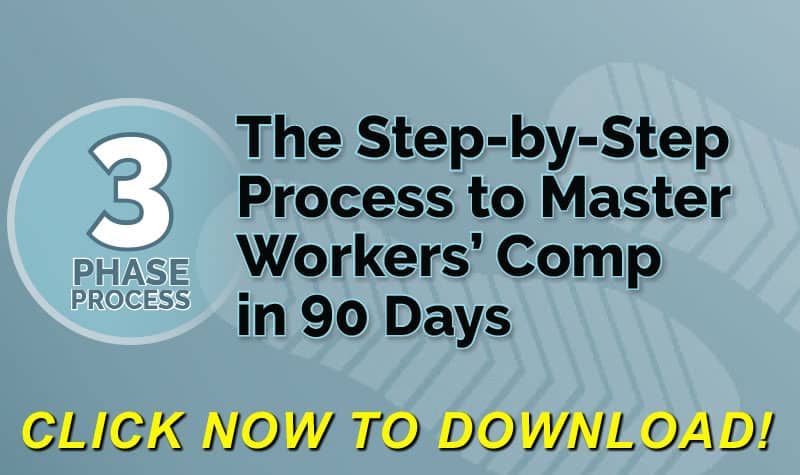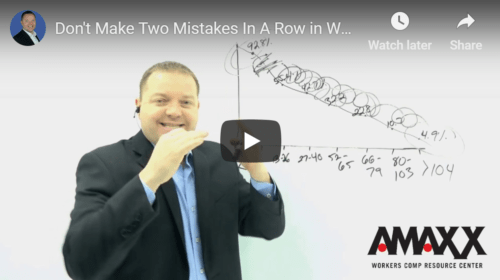
On the other hand, if a guy comes in the office and says he hurt his arm but “it is no big deal,” chances are you are going to forget about it, not make a note about it. And when he comes back in 6 months and says surgery is needed tomorrow and will be off of work for 6 months, I do not think you are going to exactly recall the brief conversation with him 6 months prior.
Click Link to Access Free PDF Download
Lag Time Is The Enemy
Lag time is also the enemy to every claims adjuster. It can affect every aspect of the claim, most importantly the compensability. For every day that goes by after someone is hurt without reporting it to the employer, or even worse he reported an injury to the employer who did not report it to the carrier/TPA, lag time is involved. Lag time is the time between date of injury and the date of reporting to the employer and from the employer to the carrier. Here are some tips to improve lag time. ASK FOR A LAG TIME REPORT FROM YOUR CARRIER. They should be giving them to you periodically, but if not, ask for it.
-
Have a system in place
Regardless of the size of the work population, you need to have a system in place. The employer is going to be faced with several different types of workers comp claims: report only, medical only, lost time, advanced lost time, and severe. A claim that is a “report only” or “incident only” should not carry the same urgency as a severe injury claim.
Every person in risk management will have a certain way of keeping records and reporting claims to the carrier/TPA. Organization is key. The system has to work, or else a claim will fall through the cracks. Get a separate file cabinet, dedicate a certain area of the office to claim paperwork, and keep separate email folders for claims. Whatever you do to create a working system stick with it. Think about prioritizing each type of claim and how each issue has to be addressed. Take it one step at a time and walk through what the responsibilities are and where you need to focus.
-
Get claims called into the carrier/TPA
A rule should be made that any claim with medical treatment needs to have the State Injury report completed and sent to the carrier/TPA within 1-2 business days. Not only does this prevent lag time from happening, but it will give the adjuster a head start on the claim from early in the injury. This can apply to medical-only claims and non-severe lost time claims. Plenty of claims start off innocently enough as a simple medical only claim. But then, 3 months later after conservative treatment fails, the injured worker is heading for surgery, which is not a guarantee that the employee will be 100% in the near future. The earlier the adjuster is involved in the claim, the better chances you have of it not spiraling out of control. Plus after it is reported and called in to the carrier, that is one less thing to worry about.
-
Call claims in with correct and complete information
Adjusters dislike it when they receive an injury report and most of the information is missing. Or the injury description reads “back strain.” Maybe the place where the employee was treated is not known, or if the injured worker even went for treatment at all. Maybe you view date of birth, social security number, job title, and complete address, as trivial information. That is okay, but the adjuster needs that information, and it needs to be accurate. It cannot take long to pull a person’s personal information up on the computer, or email the Human Resources person to seek help with that portion of the claim. Any way that it can get done, do it and then get the claim sent. Incorrect or incomplete information produces lag time from when the adjuster receives the injury report to when the TPA makes a first payment on a claim. Or even when the adjuster can make contact with the worker. If you forgot the claimant’s phone number, and did not have a complete address, how can the adjuster contact the injured worker?
-
Include the hourly wage and the gross total from a year prior to the injury date to reduce lag time
If this claim will involve wage loss, the adjuster will need the wage records. Be sure to list the hourly rate for the injured worker, as well as the gross pay from one year backwards from the injury date. This will save the adjuster time, cutting down on the lag time between injury date and date of first payment. Most states will penalize the carrier for a delay in payment after an injury occurs if there is lost time. Due to this statute, the adjuster will be requesting wage records. So why not be ahead of the game and include the records with the claim forms that are sent? The adjuster will appreciate it. And of course, it is one less thing you have to do.
-
Keep eyes and ears open on your work floor
As a risk manager or HR person, chances are you are removed from the work floor where a lot of injuries occur. But, the adjuster will be calling you to talk about the injury details. So you have to know about the machines, know the people running them, and also know who the employee’s managers are and how to talk shop with them. Your employees should know that the first contact person after an injury is their supervisor, and then that supervisor should be coming right to you to fill out the injury paperwork after they talked with the employee and sent them off for medical care. Make sure those supervisors know the importance of coming to you to report a claim. If the worker does not tell the employer about the injury, then you are not going to have a report to send.
-
Be involved with the process
We have said it time and time again, the employer must be involved. Not only at the initial stages as indicated above, but throughout the whole process. To have an effective workers comp program, there must be proper reporting, proper light duty management, and proper monitoring on all aspects of the claim. You need to communicate with the carrier/TPA for claims reviews. Get up to speed with what is going on, and what the current lag times are. Set goals to reduce lag time from late reporting and keep track of the numbers. Fix your system where it needs to be fixed. There is no perfect blueprint that will work. A program as variable as this also needs to be flexible. Make changes as needed and track to see if they improve numbers or worsen them, and then make further changes. Create the program, and then be involved in it.
FREE DOWNLOAD: “Step-By-Step Process To Master Workers’ Comp In 90 Days”
Summary
Carrier/TPAs despise lag time from late claim reporting. They keep track of it for a reason, because the greater the lag time and the later the adjuster is involved, the more the exposure risk increases. Take some of the key points listed above and see if they can be implemented into your risk management system. Keep track of the numbers. If you discover that you have a lag time problem, then you have the room and the resources to save a lot of claim expense money that is spent purely on late reporting. Like it is said, “The numbers don’t lie.” You will be amazed at how much money can be saved simply by getting that correct claim sent in to the carrier for immediate handling.
Author Michael Stack, CEO Amaxx LLC. He is an expert in workers’ compensation cost containment systems and helps employers reduce their workers’ comp costs by 20% to 50%. He works as a consultant to large and mid-market clients, is a co-author of Your Ultimate Guide To Mastering Workers Comp Costs, a comprehensive step-by-step manual of cost containment strategies based on hands-on field experience, and is founder & lead trainer of Amaxx Workers’ Comp Training Center .
Contact: mstack@reduceyourworkerscomp.com.
Workers’ Comp Roundup Blog: https://blog.reduceyourworkerscomp.com/
©2019 Amaxx LLC. All rights reserved under International Copyright Law.
Do not use this information without independent verification. All state laws vary. You should consult with your insurance broker, attorney, or qualified professional.
FREE DOWNLOAD: “Step-By-Step Process To Master Workers’ Comp In 90 Days”

















